Home » Hunting Dogs » Pudelpointer – Dog Breed Form, Function, History, and More
Pudelpointer – Dog Breed Form, Function, History, and More
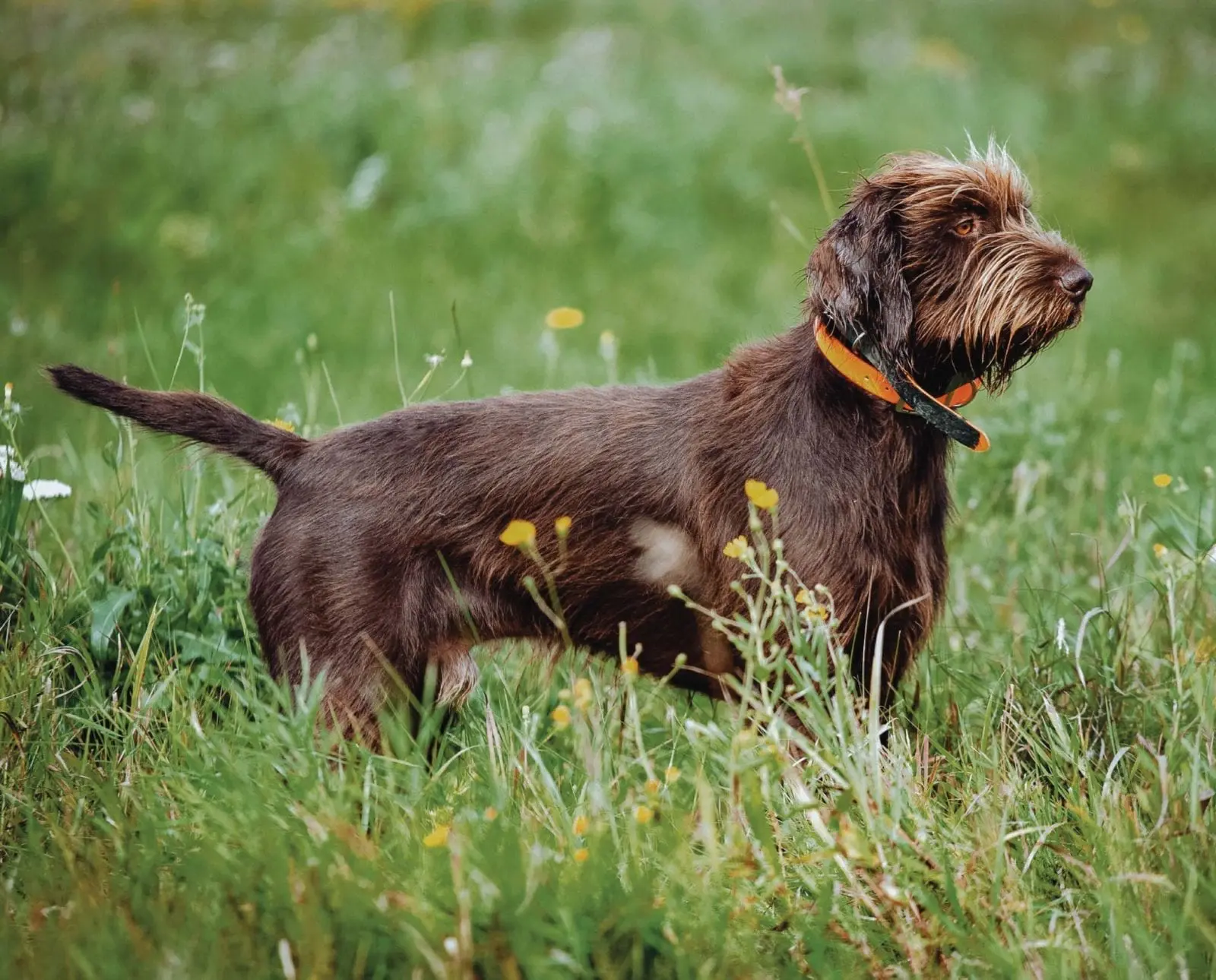
From their home base in Winnipeg, Craig Koshyk and Lisa…
This medium-sized versatile dog breed is known to be friendly, inquisitive, and very social.
Way back in 1881, German hunters began systematic crossing of Pudels and Pointers. They eventually created a superb breed of gundog and named it the Pudelpointer.
Listen to more articles on Apple | Google | Spotify | Audible
The Pudels used in the original crosses were not the same as the Poodles we have today. The German Pudel was a hunting breed known for its keen love of water, strong retrieving instinct and sharpness on predators.
Compared to other breeds of pointing dogs, pudelpointers are not particularly common. Yet Lisa and I have seen a good number of them over the years in places like Germany, France, Slovakia, the Czech Republic, the U.S. and Canada. We’ve even hunted over a number of them right here in our home province of Manitoba.
Our frequent contacts with the breed are due to the fact that when we travel to photograph dogs or to hunt, we tend to meet people who are just as passionate about hunting as we are. And since the versatile breed is and always has been in the hands of hunters, it stands to reason that we would come across more pudelpointers in a couple of seasons than the average dog walker at a local park would see in a lifetime.
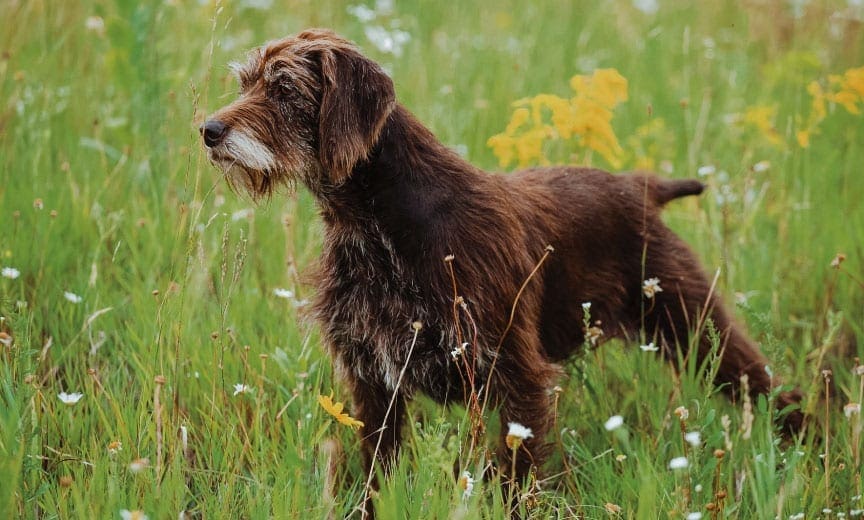
Pudelpointer Form
Pudelpointers are generally strong-boned, medium-sized gundogs similar in appearance to solid-colored German Wirehaired Pointer. The coat is usually all brown, but “dead leaf” (a somewhat lighter shade of brown) and black are also allowed. Small, white markings are permitted. The tail is docked, leaving approximately two-thirds of the original length.
Size of Pudelpointer
Males: 24-27 inches (60-68 cm) and 55-67 pounds
Females: 21.5-25 inches (55-63 cm) and 45-58 pounds
Coat of the Pudelpointer
Since the Pudelpointer’s creation, breeders have had to contend with the tricky genetics of its wire-haired coat. An ideal coat is coarse, hard and flat lying, with a 4 to 6 cm topcoat and full facial furnishings (beard and eyebrows). However, even in litters from parents with near-perfect coats, it is not unusual to find a variety of coat types ranging from smooth to woolly to “just right”. When I asked Bill Athens- an American Pudelpointer breeder with over 30 years’ experience with the breed–about the variations in the coat, he replied:
“Pudelpointer coat consistency has been an issue but we have seen much improvement. I think part of the problem in the past was the very small gene pool. There weren’t many choices in selecting breed. ing pairs. I credit NAVHDAs registry and the FDSB for allowing us to develop a larger gene pool and expand our breeder base to supply the growing demand among hunters, especially those in NAVHDA.
I recently had a litter of six pups. One woolly male, one (almost) smooth male, and the rest had very nice coats. It is funny, though; when people come to look at the pups they almost always like the ones with lots of furnishings because they are the cutest. Usually a pup with substantial furnishings at seven weeks will be woolly.
In the 17 Pudelpointer litters I have bred, I think I have only had about three or four pups that ended up with short coats, and they looked like solid liver shorthairs.”
For a hunter seeking a Pudelpointer pup, it is well worth studying the intricacies of the breed’s coat or to consult someone who can offer advice on which pup to pick.
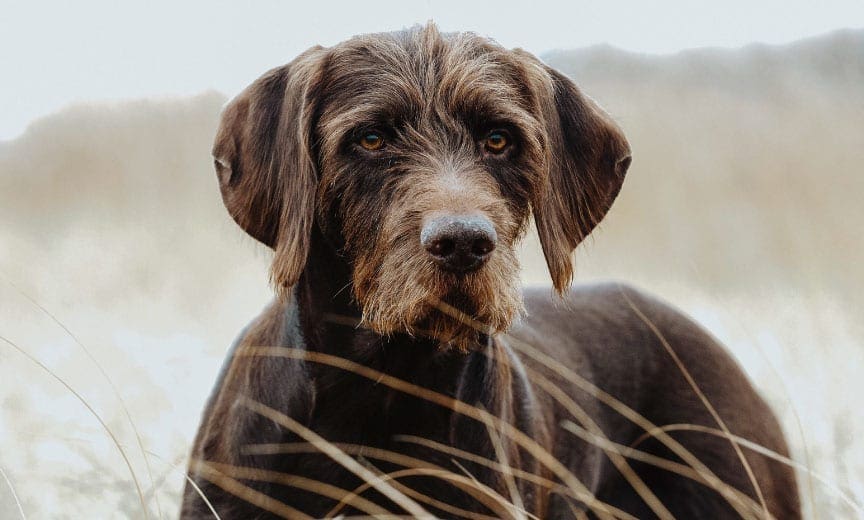
Character of the Pudelpointer
Pudelpointers are said to have a highly cooperative attitude and bond closely with their owners. They tend to be a bit mellower around the house compared to some of the other wire-haired breeds, and also said to have a playful almost clownish personality.
Pudelpointers are, on the whole, level-headed, easy-to-train, nice-to-be-around gundogs. Bill Athens also finds that they are very adaptable:
“My experiences with the PP in the past 30 years is they are not one-man dogs. You can count on them to be good family dogs, to take to training well, and to be friendly to all people. They bond easily, even when acquired as adults. They do fine in a kennel environment or living in the house. In the field, they are usually pretty serious about their role as a hunting dog.“
Jude Gerstein, a breeder in Canada, adds that:
“Pudelpointers are dogs with definite personalities, not machine-like robots. A sense of humor is an asset when owning one. They will sometimes flip you off, but they will also work until they literally drop, just to please their handler.“
Pudelpointers and Protection
While some Pudelpointers will bark at strangers, most are far too friendly and people-oriented to make good watchdogs. When I asked Jude Gerstein if her dogs would protect her home from a prowler she replied, “Not if the prowler has food!”
Training Pudelpointers
Pudelpointers are generally eager-to-please hunting dogs with a lot of desire. Most are fairly easy to train, but some can have a stubborn streak.
“Moderate training methods are usually sufficient but they can handle some force quite easily. Any dog needs to be reminded on occasion, but once trained, a Pudelpointer will retain what it has learned with minimal reminders.” (Bill Athens, pers. comm.)
“They can also have a stubborn streak-not the stubbornness of a scent hound, but you can actually see it in their eyes when the decide not to heed you.” Jude Gerstein, pers. comm.)
Pudelpointer Populations
The majority of Pudelpointers in the world are bred in Germany and the United States. In recent years, the number of pups whelped in North America, about 200 per year, has actually surpassed the number bred in Germany, where about 150 pups are registered annually. There are also breeders in Czech Republic, Slovakia, Austria, France, and the United Kingdom.
Pudelpointer Health Issues
Overall, the breed enjoys good health but some cases of hip dysplasia and epilepsy have been reported. Interestingly, the Pudelpointer’s FCI standard is one of the very few to actually mention health:
“The country of origin attaches special significance to the state of health of the Pudelpointer with special emphasis on the prevention of hip dysplasia (HD) and epilepsy in the breed.“
Pudelpointer Clubs
The parent club for the breed in Germany is the Verein Pudelpointer and their Verein Pudelpointer Club Group of North America.
There are also Pudelpointer clubs in Austria and France. In North America there are three associations for the breed: The Pudelpointer Club of North America (PCNA), The Canadian American Pudel-pointer Association (CAPA) and The North American Pudelpointer Alliance (NAPPA)-which is not really a breed club but an alliance of Pudelpointer breeders who test their dogs in NAVHDA and who agree to maintain certain breeding standards.
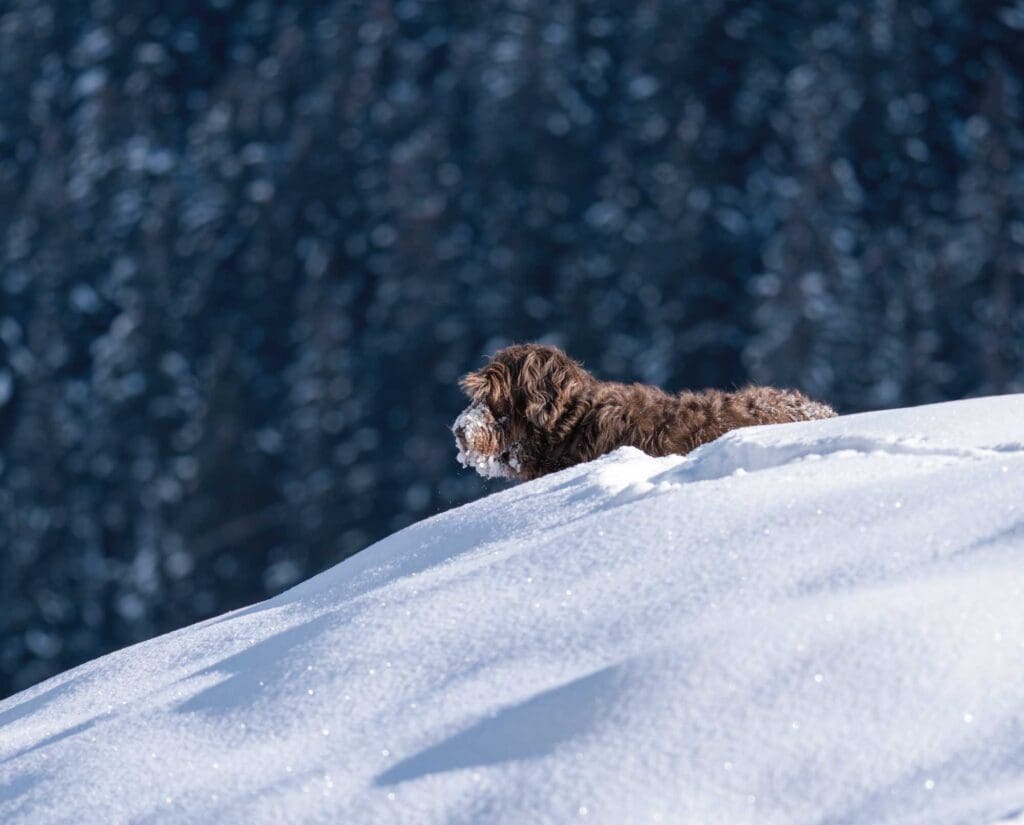
An in depth history and development of the Pudelpointer
The 1880s were a period of rapid growth in the newly united German Empire. Its industry, economy and population were booming. With improvements in travel, communication, science and education, Germany had come to rival England as Europe’s leading industrial nation.
During this time of national awakening, a vibrant sporting press promoted German hunting culture and encouraged sportsmen to develop national breeds of gun dogs for their own ways of hunting. One of the most influential writers of the time was Sigismund Freiherr (Baron) von Zedlitz und Neukirch, who wrote under the pen name Hegewald. In some published histories of the pudelpointer, he is credited with the creation of the breed — but this is misleading
Hegewald did not actually create the pudelpointer. Instead, he used his influence as a well-respected canine authority to convince others to cross water dogs he called pudels with English pointers.
In Hegewald’s time, crosses of short-haired and curly-coated dogs were nothing new. It had been going on for centuries just about everywhere. But until then, there had never been any concerted effort to deliberately and systematically cross two established breeds in order to create a completely new breed with the best qualities of both.
In the late 1800s, pointers imported from England were enjoying great popularity across Europe and were well regarded for their tremendous speed and passion in the field. They were a natural choice for anyone seeking to start a new breed. But what were the pudels that Hegewald wrote about? Today, no one seems to know much about them. But in Hegewald’s time, everyone knew what they were. In fact, as far back as 1621, Englishman Gervase Markham wrote that:
The water dog is a creature of such general use . . . that it is needless to make any large description of him . . . since not any among us is so simple that he cannot say when he sees him: this is a water dog.
Fortunately, Markham then goes on to actually describe the water dog, saying that it:
. . . may be of any color and yet excellent, and his hair in general would be long and curled, not loose and shaggy; for the first shows hardness and ability to endure the water, the other much tenderness and weakness, making his sport grievous. His head would be round and curled, his ears broad and hanging, his eye full, lively and quick, his nose very short, his lip hound-like, side and rough-bearded, his chops with a full set of strong teeth, and the general features of his whole countenance being united together would be as lion-like as might be, for that shows fierceness and goodness . . . .
The dogs Markham describes were probably the descendants of herding dogs that had long, thick coats to protect them from the elements and the strength and agility to work in the toughest conditions, including cold water. Everywhere they were found, they were crossed with other breeds, some of them short-haired.
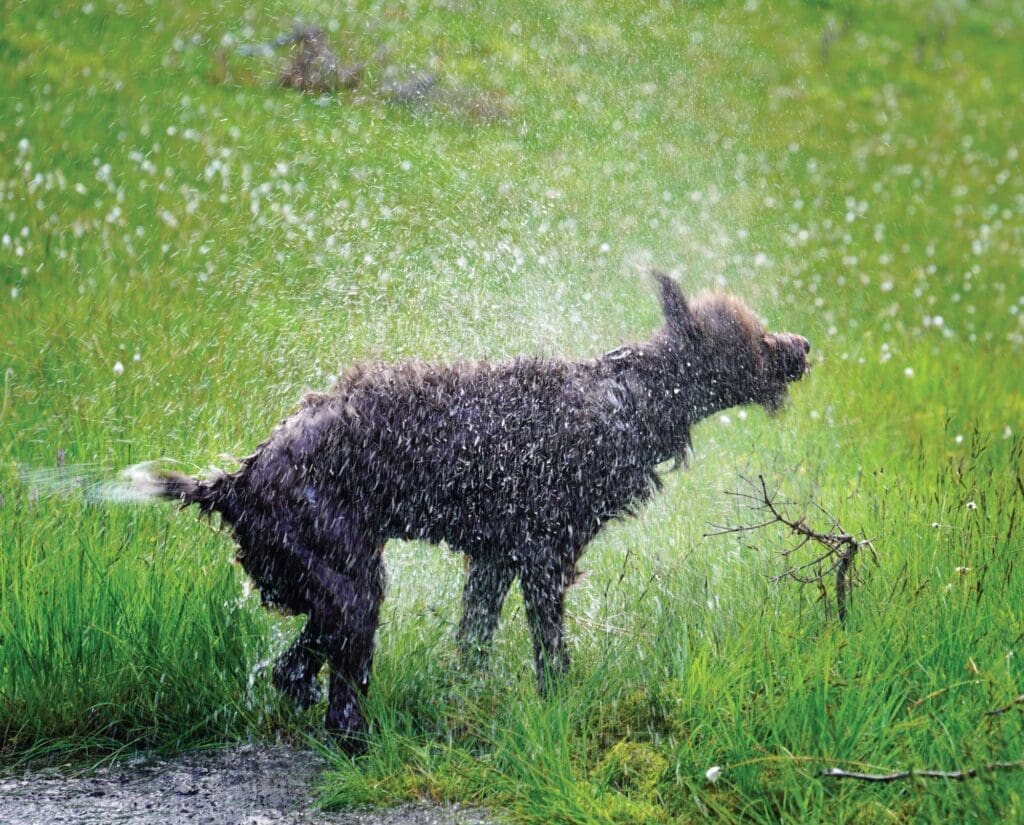
Water dogs went by different names in different regions. They were often said to come from Russia, Poland or Bohemia (modern day Czech Republic). In all likelihood, they didn’t develop in just one region since they were found across much of the continent. The names they were given were probably based more on stereotypes than the dogs’ actual origins. Jean Castaing suggests that the English called them Russian for the same reason the Germans called them Polish — because they had a rough, unkempt appearance that was considered typical of Eastern European people at the time.
Until the mid 1800s, no one deliberately set out to create a rough-haired breed from scratch by systematically crossing dogs with different coat types. But the idea of deliberate crosses had been around since at least 1825 when Freiherr (Baron) v. d. Borch wrote in the Jahrbuch für Forstmänner, Jäger und Jagdfreunde (Yearbook for Forest Men, Hunters and Friends of Hunting):
It is noteworthy that crossing the pudel and the pointing dog would unite and maintain the excellent drive by the virtues of both types.
In 1848 a Frenchman, Gaspard de Pekow, the Marquis of Cherville, may have been the first to undertake a systematic approach to breeding rough-haired dogs by crossing griffons and pointers. Aimé Guerlain continued the Marquis’ work by selecting only white and orange dogs from the Cherville line and crossing them once more to pointers. He eventually established his own breed called the Guerlain griffon.
Another Frenchman, Emmanuel Boulet, tried a different approach. Instead of starting with rough-coated griffons, he used the Barbet, a water dog with a soft, woolly coat. Eduard Korthals also began to develop his own strain of griffons around this time by crossing long, short, curly and rough-coated dogs.
Hegewald was surely aware of what these men and others were trying to do. He also knew that an accidental mating between a pudel and a pointer had already occurred in Germany. He wrote that the mother was a heavily ticked, brown pointer and the father was a strongly built, brown pudel. Apparently, the mating took place near Magdeburg while an army unit was on maneuvers in the area. An officer with one of the battalions owned the pudel that somehow ran away and managed to mate with the pointer bitch owned by a local landowner. The union produced a bitch named Juno. Her qualities ultimately inspired Hegewald to urge breeders to repeat the cross.
A forester by the name of Walter zu Walsdorf, who lived near the city of Goldberg (now Zlotoryja, Poland), is said to have mated a black half pudel / half pointer bitch named Molly to a brown and white pointer, named Tell, owned by Emperor Frederick III. The resulting litter produced at least one pup, Cora vom Walsdorf, that possessed abilities of both the pudel and the pointer and had the kind of rough-haired coat Hegewald advocated for the breed.
Encouraged by the success of the first litter, breeders began to produce more litters by crossing pudels with pointers. However, they soon realized that dogs from the first generation should not be bred among themselves since they tended to produce offspring of either the pudel or the pointer type, and not the desired blend of the two. So, a program of “back-breed- ing” was established. Dogs from the first and second generation of crosses were bred back to pointers. It is said that a total of 87 crosses to pointers were done around this time. No additional crosses to pudels were reported.
The back-breeding program helped to stabilize the look and character of the breed and eventually allowed breeders to mate pudelpointers to other pudelpointers. A breed register was created in 1892 and, in 1897, a full-fledged club, the Verein der Pudelpointer-Züchter — later renamed Verein Pudelpointer — was established.
In the early years of the club, a number of prominent members — and their dogs — were lost to the breed when they joined the movement to create the Deutsch Drahthaar (German wirehaired pointer). Those who remained held firm to their conviction that by breeding only within pudelpointer lines they could develop and maintain a rough-haired breed of gun dog with excellent all-around hunting abilities. In 1924 they joined with other purists from the griffon and Stichelhaar clubs to form the Rauhaar Reinzucht Verband (Rough-haired Pure-breeding Club) in order to hold additional performance tests for all three breeds.
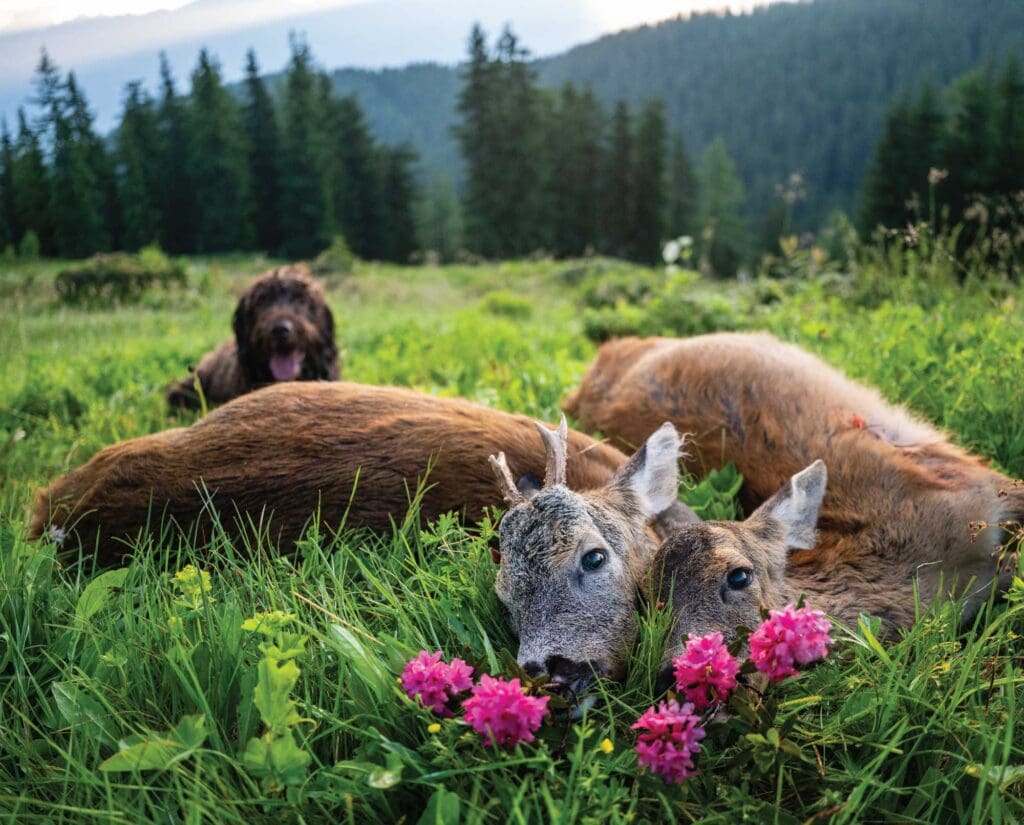
As with many of the German breeds, pudelpointers eventually made their way out of Germany, at first into neighboring countries, but eventually across the Atlantic. H.D. Hume and Sigbot “Bodo” Winterhelt, one of the founders of NAVHDA, are credited with introducing the breed into North America in 1956, where it is now appreciated by a growing number of hunters. Today, the pudelpointer enjoys a good reputation as a solid, dependable hunting dog but remains a rare breed even in its homeland. With just over 150 pups whelped there per year, it is more popular than the griffon and Stichelhaar, but nowhere near as popular as the German wirehaired pointer.
The majority of pudelpointers are bred in Germany and the U.S. In recent years, the number of pups whelped in North America, about 200 per year, has actually surpassed the number bred in Germany, where about 150 pups are registered annually. There are also breeders in the Czech Republic, Slovakia, Austria and France.
For over 100 years, the quality of the breed’s performance and conformation has been assured almost exclusively by testing systems. In Germany, the Verein Pudelpointer organizes VJP, HZP and VGP venues, as well as a special HZP named after an early supporter of the breed, Edgar Heyne. In North America, most pudelpointer breeders use the NAVHDA testing system to prove their breeding stock. They also register their dogs in the NAVHDA registry, although some register with the Field Dog Stud Book (FDSB) as well. Recently, some breeders have also begun testing with the newly formed Versatile Hunting Dog Federation (VHDF).
Pudelpointers are generally strong-boned, medium-sized gundogs similar in appearance to solid-colored German wirehaired pointers. The coat is usually all brown, but “dead leaf ” (a somewhat lighter shade of brown) and black are also allowed. Small, white markings are permitted. The tail is docked, leaving approximately two-thirds of the original length.
Like all breeds of gun dogs, there is a certain amount of variation in terms of performance from one pudelpointer to the next. However, there is little to no variation in one very important aspect: the vast majority of pudelpointers hunt. There are no show lines of pudelpointers, no high-volume breeders producing pups for the pet market, no national “rescue” organization to re-home unwanted pudelpointers purchased at pet stores. While there may be some differences between pudelpointers bred in Europe, where a closer-working dog is preferred, and those bred in the U.S. where there is a preference for faster, bigger-running dogs, pudelpointers are generally considered to be among the top pointing breeds in terms of speed and range. They are powerful, busy workers that cover a fairly wide area at a medium to fast gallop.
Most pudelpointers show a very strong pointing instinct that develops early. Many are natural backers. Lines bred in the U.S. may show a slightly higher head and tail when pointing. Their European cousins tend to point in a more Continental style: level head, back and tail.
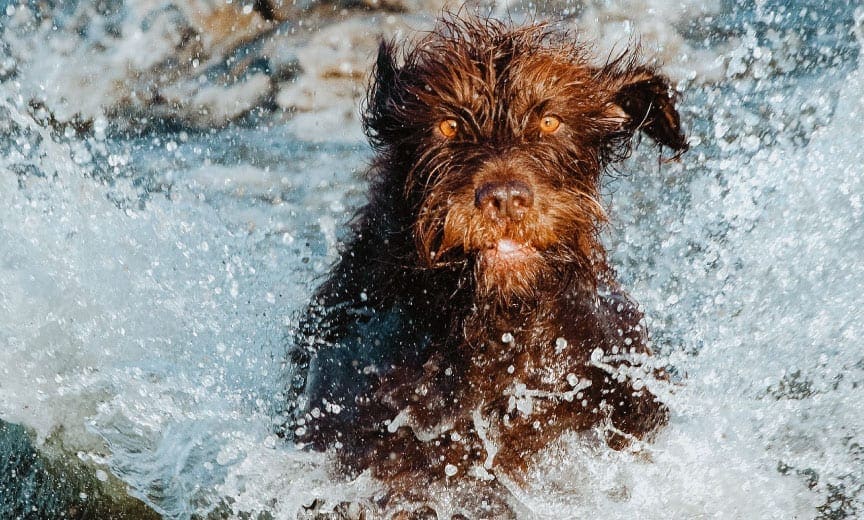
Pudelpointers have proven their worth as retrievers in the highest-level tests in Germany and North America. A strong, early developing instinct to retrieve, combined with a good, protective coat makes the pudelpointer one of the better choices for waterfowlers. Pudelpointers can also make excellent trackers of large and small game. In Germany, giving voice on trail (spurlaut) or on sight (sichtlaut) is now a requirement for breeding. In North America, the breed’s tracking talents are mainly used for the recovery of wounded game birds, waterfowl and small game.
The founders of the breed specifically chose the pudel for its love of water and its strong will to retrieve. As a result, pudelpointers have consistently excelled as water dogs and are often owned by dedicated waterfowl hunters who rely on them to fetch ducks and geese in harsh conditions.
In terms of character, pudelpointers tend to be friendly, inquisitive dogs that get along well with other dogs. They are said to be level-headed, easy-to-train, nice-to-be-around gun dogs and may be a bit mellower around the house compared to some of the other wirehaired breeds. They are also said to have a playful, almost clownish personality.
I’ve seen North American-bred and German pudelpointers. I’ve run my dogs in fun trials and training sessions with an excellent pudelpointer owned by one of the people in our local pointing dog club. And I remember a fantastic photo shoot in Ontario with pudelpointers that hit the water like Labs. In all of these encounters, I never felt the least bit intimidated by any of the dogs. Every pudelpointer I’ve ever met has been an easygoing, friendly dog whether it was in the house, in a camper or staked out beside a truck.
In the field, they all hunted hard. Sure, some were faster and bigger-running than others. Some were also better looking than others — I can confirm the variation in coat quality in the breed — but not a single one of them left me with any doubt about their hunting desire. For me and many other fans of the breed, the bottom line on pudelpointers is this: they are the real deal. They are dynamic hunting dogs bred by hunters, for hunters.
From their home base in Winnipeg, Craig Koshyk and Lisa Trottier travel all over hunting everything from snipe, woodcock to grouse, geese and pheasants. In the 1990s they began a quest to research, photograph, and hunt over all of the pointing breeds from continental Europe and published Pointing Dogs, Volume One: The Continentals. The follow-up to the first volume, Pointing Dogs, Volume Two, the British and Irish Breeds, is slated for release in 2020.

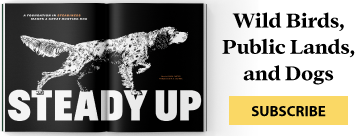



Late to get a Pudelpointer but am certainly happy with my Dixie. Only dog I’ve ever seen that plunges her head into the water bucket and drinks, not laps!
I can confirm this trait. They also immediately then place their mop of a beard on your knee and expect scratches.
Just saw your reply. What is the blood line of your ‘head-plunging drinker’ PP? Mine is:
Sire – Oxbow’s Big Gun —- Dam – Indian Summer’s Benevolent Lucille welped 10/21/17. She is Indian Summer’s Dixie. Drop me an email — drjtbos@gmail.com
Great article, Craig! Thank you.
Well written informatively. Thank You
Well written article. I am a little biased as I hunt over one. Couldn’t ask for a better hunter and companion in the house.
I just got my second Pudelpointer. They are great dogs.
Great article! We’ve got a nine month PP and I couldn’t agree more with what you’ve said above desire and personality. Our pup loves to be cuddled in the house, but as soon as it’s hunt time he doesn’t want to be touched. Thanks!
People will let the name bother them and they have no idea what they’re missing. At clinics, trials or hunting with others they said, “It’s a what?! ha Ha Ha!”. But at the end of the day I’ve heard people say, “Ok I’ll shut up now.” Others will walk away without saying anything because they know their dog were just outshined by ours. If the Pudelpointer could talk he’d say, “And don’t you forget it either!”
I miss my two dearly. And that was a good article Craig.
I so miss my Jessie, she was also the Real Deal! Tirelessly hunting over land or water, wonderful personality, even would search and find lost items of others when give a sample scent. Like a cell phone of a friend in a freshly cut hayfield!
Great article. I’ve always been a Brittany owner, but am intrigued by this breed.
I made the same jump 6 years ago. My old man was a Brittany breeder when I was a kid. I still love them, but I’m not going back. I hunt a lot of ducks and there’s no comparison in that regard.
Fantastic article! I’m on my 4th pudelpointer, the 1st three came from Bodo Winterhelt. Everything you said about their hunting abilities and temperament are correct. Great dogs to spend a day in the filed with.
I live in Maryland and looking for a breeder in my neck of the woods … if anyone knows of one please pass along my email address
davidmccown@gmail.com
David, check out http://www.pudelpointer.net/. PP breeders are held to a higher standard than most other breeds and the North American Pudelpointer Breeder’s Alliance makes sure these breeders are holding to that standard. That being said, I’ve seen some great dogs from breeders that don’t show up on the alliance – maybe someone else can speak to that. Most breeder’s waiting lists are a year or more out. My suggestion would be to reach out to all the breeders and find one that has a line that matches your hunting style, then get on a waiting list. I wouldn’t focus so much on geographical location (within reason) as you will be limited on availability with this breed. I’m on my first PP (now 13 months old, from Tom Vontz at Indian Summer Kennels) and I flew from Utah to Kansas to get him (he flew home on my lap). It adds a little more to the cost of the dog, but you’ll be with your dog for over a decade and, in my opinion, it’s worth the extra money to get exactly what you’re looking for. Feel free to reach out to me if you have any questions, but be warned: I’m only going to talk about how the PP is a superior hunting dog to all others.
stephencraigdavis@gmail.com
thanks for your excellent suggestions!
You may have to travel – or have the dog travel. Contact the
Website in this section to obtain a dynamite PP. they’re wonderful dogs so don’t fall for a fake!!!
Thank you for a very complete history of these wonderful hunting companions. My first dog was a Pointer who was found at an Iowa duck marsh parking lot. She was without a collar and had either become entangled, lost or dumped because of her extreme range. She was a wonderful house dog but disliked putting her feet in water and was difficult to recall because of her intense search and drive instincts.
My best friend, Vic Connors, was NAVDAs president for five years and arranged an interview with a Canadian breeder to see if I could get one. Vic was a Senior Judge and traveled widely to judge all of the NAVHDA breeds. He had prized Setters, GPS, and German Wirehaired Pointers. He could have gotten a good deal from many breeders, but finally chose and stuck with the PPs. We hunted together and he noticed how quickly mine came around with novice training.
I am anxious to adopt my fifth one in a few days, a seven week old, black male found in Minneapolis.
I have owned two Pudelpointers. The first one was direct from Bodo, probably one his last few breedings. He was a robust, incredible hunter and was with me for 13 years and hundreds of birds. My second one was from a “prominent” western breeder and showed great potential a pup. Within the first year he showed signs of some immune system problems. His belly coat was soft and minimal. Long story short, after 3 years and thousands of dollars, he succumbed to a terrible immune disorder. I was promised a replacement pup, but that never happened. I switched to Drahts and never looked back. Much broader gene pool in the U.S. Be careful and diligent when buying a PP.
Forgot to mention…..great article!
We have had our Pudelpointer for 5 years now. I can say he is the best family/bird dog we have ever had. We had always gone with the Labradors, but the last 4 have died of cancer. they were all registered, so our opinion is that the breed is very interbred. Note: I’m not a vet, just a person who always had labs.
Tukr, is a momma’s boy, but when the guns come out no one but the birds are on his mind.
I believe we will stay with Pudelpointers for the rest of our hunting lives.
I love the articles about this breed in the magazine.
Thank you.
Great article Craig!
As always, you captured the breed in all respects in a well penned article. I’m still basking in delight to the reference of “clownish personality”…so true and yet so admired.
Great dogs they nailed it love my dog